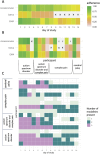The Living Lab at Home: Feasibility and Acceptability of Multimodal In-Home Data Collection Among Youth Across the Developmental Spectrum
- PMID: 39446061
- PMCID: PMC11634160
- DOI: 10.1097/DBP.0000000000001319
The Living Lab at Home: Feasibility and Acceptability of Multimodal In-Home Data Collection Among Youth Across the Developmental Spectrum
Abstract
Objective: Dynamic, real-time, in-home methods of data collection are increasingly common in child health research. However, these methods are rarely cocreated or used with families of youth with developmental disabilities. We aimed to determine the feasibility of codesigned methods for in-home data collection for youth across the developmental spectrum.
Methods: Sixteen youth (14-18 years) with autism spectrum disorder, cerebral palsy, and/or chronic pain completed 14 days of data collection, wearing an accelerometer, answering Ecological Momentary Assessment (EMA) questionnaires, and collecting salivary cortisol samples. Participants completed a poststudy interview regarding their experiences. Data were analyzed for feasibility, quantity, and quality.
Results: At least 1 EMA response was provided on 73% of days, with 54% of the total number of administered prompts answered before the next prompt arrived. In total, 77% of participants wore the accelerometer ≥10 hours for at least 7 days. Adherence to 8-day saliva sampling after accounting for protocol violations and dry samples was 28%. No significant adverse events were reported aside from mild emotional distress (25%). Families reported generally high satisfaction, willingness to participate again, and acceptability, with moderate burden and interference. Qualitative interviews described: (1) the research question's value to the family as a motivator of engagement; (2) in-home data collection is not a passive or neutral experience; (3) personalized approaches and context are important to families; and (4) a clear need for continued iteration and engagement.
Conclusion: In-home multimodal data collection is potentially feasible for families across the developmental spectrum but requires iteration based on family feedback to increase adherence.
Copyright © 2024 The Author(s). Published by Wolters Kluwer Health, Inc.
Conflict of interest statement
K. E. Boerner was supported by a postdoctoral fellowship from the Canadian Child Health Clinician Scientist Program. Both K. E. Boerner and V. Dudarev received support as a The Webster Scholars in Child Development and Neuroscience for this research. T. F. Oberlander is the R. Howard Webster Professor in Brain Imaging and Child Development. The remaining authors declare no conflict of interest.
Figures


Similar articles
-
Feasibility and acceptability of intensive, real-time biobehavioral data collection using ecological momentary assessment, salivary biomarkers, and accelerometers among middle-aged African Americans.Res Nurs Health. 2020 Sep;43(5):453-464. doi: 10.1002/nur.22068. Epub 2020 Aug 27. Res Nurs Health. 2020. PMID: 32856310 Free PMC article.
-
Family Perspectives on In-Home Multimodal Longitudinal Data Collection for Children Who Function Across the Developmental Spectrum.J Dev Behav Pediatr. 2023 May 1;44(4):e284-e291. doi: 10.1097/DBP.0000000000001183. Epub 2023 Apr 14. J Dev Behav Pediatr. 2023. PMID: 37074803 Free PMC article.
-
Combining Ecological Momentary Assessment and Social Network Analysis to Study Youth Physical Activity and Environmental Influences: Protocol for a Mixed Methods Feasibility Study.JMIR Res Protoc. 2025 Feb 21;14:e68667. doi: 10.2196/68667. JMIR Res Protoc. 2025. PMID: 39984166 Free PMC article.
-
Compliance With Mobile Ecological Momentary Assessment Protocols in Children and Adolescents: A Systematic Review and Meta-Analysis.J Med Internet Res. 2017 Apr 26;19(4):e132. doi: 10.2196/jmir.6641. J Med Internet Res. 2017. PMID: 28446418 Free PMC article.
-
Methodology Used in Ecological Momentary Assessment Studies About Sedentary Behavior in Children, Adolescents, and Adults: Systematic Review Using the Checklist for Reporting Ecological Momentary Assessment Studies.J Med Internet Res. 2019 May 15;21(5):e11967. doi: 10.2196/11967. J Med Internet Res. 2019. PMID: 31094349 Free PMC article.
Cited by
-
Insights From the International Consensus on Neuro-Irritability in Pediatric Palliative Care: Expanding the Known, Challenging the Unknown.Neurol Clin Pract. 2025 Oct;15(5):e200525. doi: 10.1212/CPJ.0000000000200525. Epub 2025 Aug 11. Neurol Clin Pract. 2025. PMID: 40799357 Free PMC article.
References
-
- Iida M, Shrout PE, Laurenceau JP, et al. . Using intensive longitudinal methods in psychological research. In: Cooper H Coutanche MN McMullen LM et al. , eds. APA Handbook of Research Methods in Psychology: Foundations, Planning, Measures, and Psychometrics. 2nd ed. Washington, DC: American Psychological Association; 2023:1:327–359.
-
- Khor AS, Gray KM, Reid SC, et al. . Feasibility and validity of ecological momentary assessment in adolescents with high-functioning autism and Asperger's disorder. J Adolesc. 2014;37:37–46. - PubMed
-
- Nestor B, Delecourt B, Baumer A, et al. . Feasibility and acceptability of fitbits for assessment of physical activity and sleep in pediatric pain. J Pain. 2024;25:54.
MeSH terms
Substances
Grants and funding
LinkOut - more resources
Full Text Sources
Medical
Research Materials
Miscellaneous

